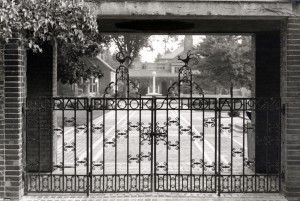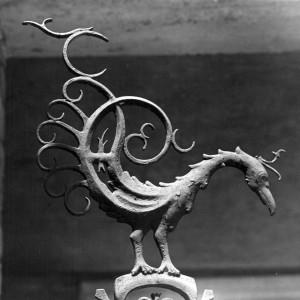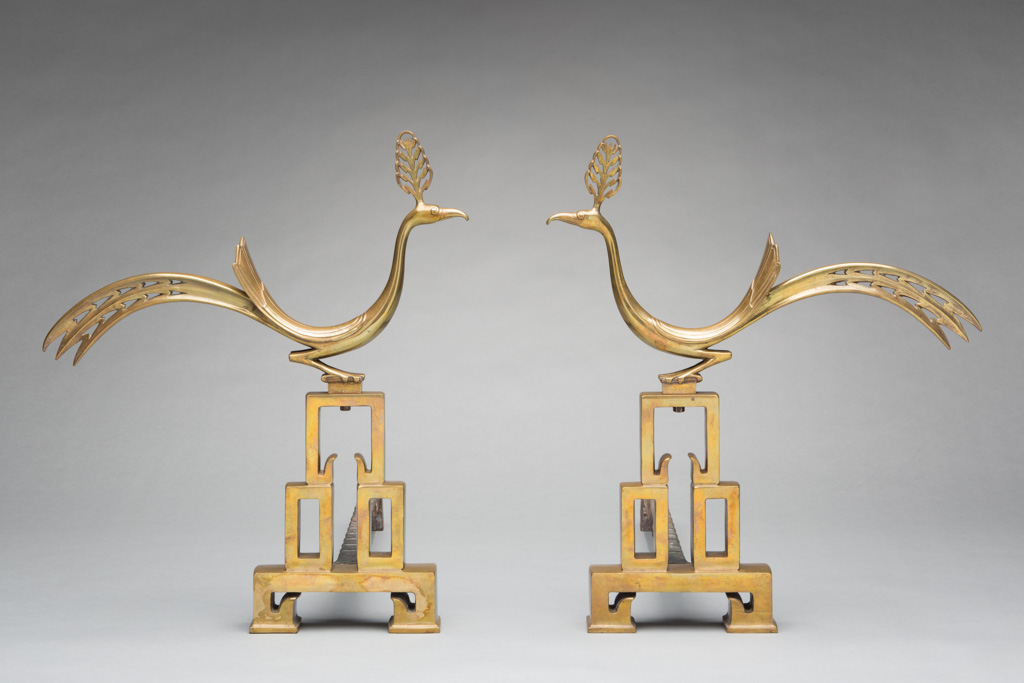When I started giving tours of Saarinen House more than twenty-two years ago, I was enthralled by the geometric designs architect Eliel Saarinen and his wife Loja Saarinen created for their own home.

Second Floor Hallway Seating Alcove reproduction curtain, circa 1993-94. Balthazar Korab, Photographer.
In the Second Floor Hallway Seating Alcove, I tended to focus upon the dramatic dance between Loja’s curtain design and Eliel’s leaded glass windows. Her woven bands of blue and green triangles layered over his geometric forms. His leaded triangles, squares, and rectangles peeking from behind her sheer textile. The combination of the two casting mesmerizing shadows across the upstairs walls, shifting with the weather and the season.
As a decorative art historian, I reveled in sharing the story of the Saarinens’ support of Finnish National Romanticism—a late nineteenth- and early twentieth-century movement celebrating the revival of Finnish language and culture, particularly architecture, arts, and crafts. And to my eye, the upstairs curtain was just another pattern derived from the Saarinens’ Finnish heritage, specifically traditional Karelian motifs found in eastern Finland and Russia.
But then, an unnamed visitor from Finland introduced me to the Kalevala—Finland’s epic poem. And I learned that the upstairs alcove curtain quite possibly had a more intriguing story to tell…
Said the aged Väinämöinen,
And he spoke the words which follow:
“Now my inclination leads me
Unto Metsola to travel;
To the forest’s daughter’s dwelling,
And to the Blue Maiden’s homestead.
Leaving men, I seek the forest,
Heroes leave, for distant regions;
Take me as thy man, O forest,
Take me, Tapio, for thy hero.
May good fortune now be granted,
And to fell the forest-beauty![”]
Translation from the original Finnish by William Forsell Kirby in Kalevala: The Land of the Heroes, in Two Volumes, 1907, “Runo XLVI: Väinämöinen and the bear.”
Could a figure from the Kalevala be hidden within the bands of triangles on the upstairs curtain?
The Kalevala recounts Finnish and Karelian folklore—heroic tales spanning the story of creation to the introduction of Christianity. Compiled by Elias Lönnart from oral tradition, it was first published in Finnish in 1835 and expanded in 1849. Many translations followed, often with creative spellings.
With ever-increasing nationalism—leading to the creation of Finland as an independent country in 1917—Finns, particularly artists, makers, musicians, and performers, turned to the Kalevala for inspiration. Apparently, the Saarinens were no exception.
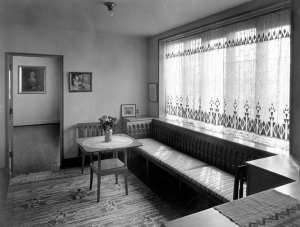
Second Floor Hallway Seating Alcove with original curtain, circa September 1930. Max Habrecht, Photographer. Courtesy Cranbrook Archives.
The original curtain for the upstairs seating alcove was designed by Loja Saarinen and woven by Studio Loja Saarinen, circa 1930. Bands of triangular forms embellish the top and bottom of the sheer panel. In typical northern-European style, its purpose was to provide a level of privacy without preventing limited daylight from streaming through. Fitting, as the Saarinens took breakfast upstairs in the west-facing seating alcove each morning at 7:30 a.m.
Cranbrook’s black and white photograph of the upstairs seating alcove was published in the October 1933 issue of House Beautiful, with the caption:
In this hall on the second floor the specifically designed furniture from the Cranbrook Cabinet Makers’ Shop and the curtains of natural linen with blue and green geometric figures, from the Cranbrook Looms, give the note of distinction that is seen throughout the house. Pattern in pleasantly contrasted here with plain surfaces, and the result is the restfulness that comes with restraint[.]
Sadly, Loja Saarinen’s original curtain no longer exists. And other than the black and white photograph and magazine caption, there is no archival documentation—sketches, studio production records, receipts, or letters—to reveal Loja’s intentions or inspirations. Close analysis of the black and white image does reveal two shades of color—presumably blue and green as stated in the magazine caption—enabling the Saarinen House restoration team to determine which color was applied where.
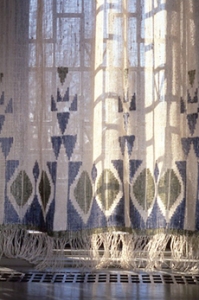
Second Floor Hallway Seating Alcove reproduction curtain circa 1993-94, detail. Balthazar Korab, Photographer.
The curtain was reproduced in 1992, by Paula Stebbins Becker, designer and Laura Sansone, weaver. Based on Loja Saarinen’s original design, two horizontal repeats—one at the bottom and one at the top—were woven in blue and green. Measuring 61 inches by 140 inches, the reproduction curtain was constructed with linen warp, lumpy low linen weft, and wool inlay, using a plain weave with supplementary weft inlay border, and fringe.
With my newfound Kalevala clarity, the repeating pattern of Loja’s textile took on new meaning.
The stacked blue triangles at the bottom of the curtain suddenly assumed the form of a towering male figure sprouting a green triangular head. This recurring figure now balanced upon blue cliffs. And blue hills and trees, flanked by green meadows, unfurled below him, while blue mountaintops and clouds danced above.
The scale of the figure in relation to the surrounding elements suggested a deity or hero, not an ordinary man.
Was Loja depicting Väinämöinen?
The central figure of the Kalevala, Väinämöinen is the symbolic first man. Of mythical origins, he rises from a primordial realm beneath the sea. An ancient hero and wise man—think Gandalf or Dumbledore—he possesses a magical voice for song and poetry. He contributes to the creation of the world by cutting down forests and mowing meadows.
Wainamoinen, wise and ancient,
Made himself an axe for chopping,
Then began to clear the forest,
Then began the trees to level,
Felled the trees of all descriptions,
Only left the birch-tree standing
For the birds a place of resting,
Where might sing the sweet-voiced cuckoo,
Sacred bird in sacred branches.
#
Wainamoinen, wise and ancient,
Brings his magic grains of barley,
Brings he forth his seven seed-grains,
Brings them from his trusty pouches,
Fashioned from the skin of squirrel,
Some were made from skin of marten.
Thence to sow his seeds he hastens,
Hastes the barley-grains to scatter,
Speaks unto himself these measures:
“I the seeds of life am sowing,
Sowing through my open fingers,
From the hand of my Creator,
In this soil enriched with ashes,
In this soil to sprout and flourish.
Excerpts from “Rune II: Wainamoinen’s Sowing” as translated by John Martin Crawford in his 1888 publication, The Kalevala: The Epic Poem of Finland based on a German translation by Franz Anton Schiefner published in 1852.
Or was it Tapio himself gracing Loja’s curtains?
The God of the Forest and Woodlands, Tapio is the personification of Nature. Described as a tall, slender figure, wearing a coat of tree moss and a fir-leaf hat, the proverbial Green Man was said to have a lichen beard and eyebrows of moss. Cue the green triangle atop Loja’s figure—perhaps a stylized pre-Christian foliate head?
“Grant, O Ukko, my Creator,
That the signs may guide our footsteps,
That the notches in the pine-tree
May direct my faithful people
To the bear-dens of the woodlands;
That great Tapio’s sacred bugle
May resound through glen and forest;
That the wood-nymph’s call may echo,
May be heard in field and hamlet,
To the joy of all that listen!
Let great Tapio’s horn for ages
Ring throughout the fen and forest,
Through the hills and dales of Northland
O’er the meadows and the mountains,
To awaken song and gladness
In the forests of Wainola,
On the snowy plains of Suomi,
On the meads of Kalevala,
For the coming generations.”
From Crawford’s translation of The Kalevala, “Rune XLVI: Otso the Honey-eater.”
Musical inspiration for the curtains?
We can hear Tapio’s horn and the mystical vibrations of Tapiola—the forest where Tapio lived and ruled—in the haunting tone poem “Tapiola” by the Saarinens’ close friend and noted Finnish composer, Jean Sibelius.
Click here to listen to “Tapiola,” Opus 112 as performed by the Gothenburg Symphony, conducted by Detroit Symphony Orchestra Music Director Emeritus Neeme Järvi, set to scenes of Finland’s forests, lakes, rock formations, and clouds edited from the 1984 Christopher Nupen film, Jean Sibelius: The Early Years, and published on the GreatClassicRecords YouTube channel in 2012.
Yet, Väinamönen plays his own role in Sibelius’s repertoire. “Väinö’s Song,” a cantata for mixed chorus and orchestra, evokes the song of our hero as a suitor in “Rune XVIII: The Rival Suitors” from the Kalevala.
Click here to listen to “Väinö’s Song,” Opus 110 as performed by the Finnish National Opera Orchestra and Chorus, conducted by the late Eri Klas, former Principal Guest Conductor of the Finnish National Opera.
Sibelius composed “Väinö’s Song” in 1926, and it was first performed in Sortavala, Republic of Karelia, Russia, in June of that year. Simultaneously, he was working on “Tapiola,” a commission from the New York Philharmonic Society first performed in New York the day after Christmas 1926.
Sibelius provided the following prose, as adapted by his publisher, Breitkopf & Härtel, to clarify his score and the role of Tapio and the Tapiola forest in Finnish mythology:
Wide-spread they stand, the Northland’s dusky forests,
Ancient, mysterious, brooding savage dreams;
Within them dwells the Forest’s mighty God,
And wood-sprites in the gloom weave magic secrets.
However fanciful it might be, I like to picture the Saarinens in the 1926 Karelian and New York audiences, supporting their good friend’s compositions and drawing inspiration for their own work. The timing is feasible as they summered in Finland and resided in Michigan during the winter—their custom excepting the war years. But more likely, they learned of the compositions through their regular correspondence with Sibelius, now in the collection of the Sibelius Museum. Perhaps the subject of a future blog post and my excuse for another trip to Finland?
It is fair to assume that by 1930, when the upstairs alcove curtain was created, the Saarinens were familiar with “Väinö’s Song” and more so, “Tapiola,” now considered to be Sibelius’s last great masterpiece for orchestra. In all, Sibelius created over a dozen works inspired by the Kalevala. He profoundly impacted the development of the Finnish national identity—and thereby the Saarinens’—adding another layer of interpretation to Loja’s figurative pattern.
Karelian geometric patterns? Väinämöinen creating the world? Tapio ruling the forest?
Whether the curtain in the Second Floor Hallway Alcove at Saarinen House depicts Tapio, God of the Forest and Woodlands . . . or Väinämöinen, the hero of the Kalevala . . . or simply references Karelian geometric patterns, I do not know. But it seems clear that Finnish Nationalism Romanticism impacted Loja Saarinen’s textile designs, reflecting both tradition and her distinctive sense of visual harmony in their arrangement of color and form.
A trained sculptor familiar with traditional weaving, Loja established Studio Loja Saarinen at Cranbrook in 1928 in order to supply textiles for the growing campus. This led to the formation of the Department of Weaving and Textile Design at Cranbrook Academy of Art, for which she served as Head from 1929 until her retirement in 1942.
Studio Loja Saarinen was initially engaged in creating textiles for Kingswood School for Girls and the Saarinens’ own home at Cranbrook. The studio also received commissions from major architects of the period such as Frank Lloyd Wright. Textiles designed by Loja and Eliel Saarinen for Studio Loja Saarinen continue to grace the interiors of notable edifices designed by Eliel, including First Christian Church in Columbus, Indiana, and, of course, Saarinen House.
Tours of Saarinen House resume on May 3, 2019. And our upcoming Day Away trip just happens to be to Columbus, Indiana—tentative dates: May 17-19. We hope to see you next season.
In the meantime, don’t forget to celebrate Kalevala Day on February 28—commemorating the date of its first publication by Elias Lönnart in 1835!
– Diane VanderBeke Mager, Collections Interpreter, Cranbrook Center for Collections and Research
